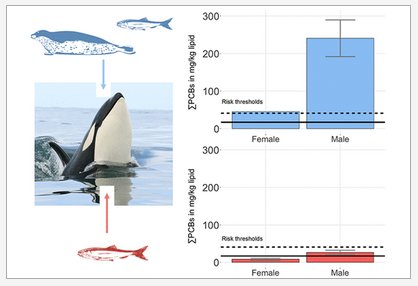Individual Prey Specialization Drives PCBs in Icelandic Killer Whales
New publication by Anaïs Remili, Robert J. Letcher, Filipa I.P. Samarra, Rune Dietz, Christian Sonne, Jean-Pierre Desforges, Gislí Víkingsson, David Blair, and Melissa A. McKinney

Abstract:
Interindividual variation in prey specialization is an essential yet overlooked aspect of wildlife feeding ecology, especially as it relates to intrapopulation variation in exposure to toxic contaminants. Here, we assessed blubber concentrations of an extensive suite of persistent organic pollutants in Icelandic killer whales (Orcinus orca). Polychlorinated biphenyl (PCB) concentrations in blubber were >300-fold higher in the most contaminated individual relative to the least contaminated, ranging from 1.3 to 428.6 mg·kg-1 lw. Mean PCB concentrations were 6-to-9-fold greater in individuals with a mixed diet including marine mammals than in fish specialist individuals, whereas males showed PCB concentrations 4-fold higher than females. Given PCBs have been identified as potentially impacting killer whale population growth, and levels in mixed feeders specifically exceeded known thresholds, the ecology of individuals must be recognized to accurately forecast how contaminants may threaten the long-term persistence of the world's ultimate marine predator.
